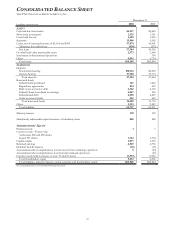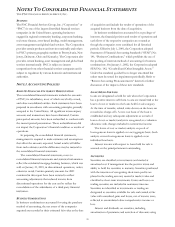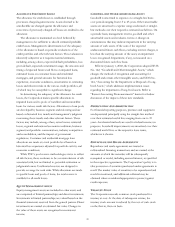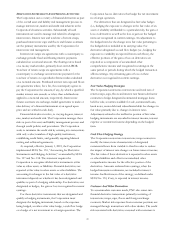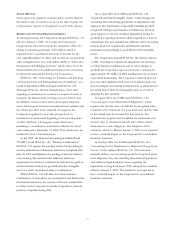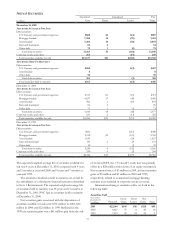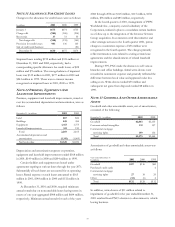PNC Bank 2001 Annual Report Download - page 72
Download and view the complete annual report
Please find page 72 of the 2001 PNC Bank annual report below. You can navigate through the pages in the report by either clicking on the pages listed below, or by using the keyword search tool below to find specific information within the annual report.70
essentially the same as that involved in extending loans and is
subject to normal credit policies. Collateral may be obtained
based on management’s assessment of the customer.
Additionally, the Corporation enters into other derivative
transactions for risk management purposes that are not
designated as accounting hedges. The positions of customer
and other derivatives are recorded at fair value and changes
in value are included in noninterest income.
Derivative Instruments And Hedging Activities – Pre-SFAS
No. 133
Prior to January 1, 2001, interest rate swaps, caps and floors
that modified the interest rate characteristics (such as from
fixed to variable, variable to fixed, or one variable index to
another) of designated interest-bearing assets or liabilities
were accounted for under the accrual method. The net
amount payable or receivable from the derivative contract
was accrued as an adjustment to interest income or interest
expense of the designated instrument. Premiums on
contracts were deferred and amortized over the life of the
agreement as an adjustment to interest income or interest
expense of the designated instruments. Unamortized
premiums were included in other assets.
Changes in the fair value of financial derivatives
accounted for under the accrual method were not reflected
in results of operations. Realized gains and losses, except
losses on terminated interest rate caps and floors, were
deferred as an adjustment to the carrying amount of the
designated instruments and amortized over the shorter of the
remaining original life of the agreements or the designated
instruments. Losses on terminated interest rate caps and
floors were recognized immediately in results of operations.
If the designated instruments were disposed of, the fair value
of the associated derivative contracts and any unamortized
deferred gains or losses were included in the determination
of gain or loss on the disposition of such instruments.
Contracts not qualifying for accrual accounting were marked
to market with gains or losses included in noninterest
income.
Credit default swaps were entered into to mitigate credit
risk and lower the required regulatory capital associated with
commercial lending activities. If the credit default swaps
qualified for hedge accounting treatment, the premium paid
to enter into the credit default swaps was recorded in other
assets and deferred and amortized to noninterest expense
over the life of the agreement. Changes in the fair value of
credit default swaps qualifying for hedge accounting
treatment were not reflected in the Corporation’s financial
position and had no impact on results of operations.
If the credit default swap did not qualify for hedge
accounting treatment or if the Corporation was the seller of
credit protection, the credit default swap was marked to
market with gains or losses included in noninterest income.
Due to the particular structure of the Corporation’s
credit default swaps discussed in the preceding paragraphs,
these instruments are not considered financial derivatives
under the provisions of SFAS No. 133. Commencing
January 1, 2001, the premiums paid to enter credit default
swaps not considered to be derivatives are recorded in other
assets and amortized to noninterest expense over the life of
the agreement.
ASSET MANAGEMENT AND FUND SERVICING FEES
Asset management and fund servicing fees are recognized
primarily as the services are performed. Asset management
fees are primarily based on a percentage of the fair value of
the assets under management and performance fees based on
a percentage of the returns on such assets. Fund servicing
fees are primarily based on a percentage of the fair value of
the assets, and the number of shareholder accounts,
administered by the Corporation.
INCOME TAXES
Income taxes are accounted for under the liability method.
Deferred tax assets and liabilities are determined based on
differences between financial reporting and tax bases of
assets and liabilities and are measured using the enacted tax
rates and laws that are expected to be in effect when the
differences are expected to reverse.
EARNINGS PER COMMON SHARE
Basic earnings per common share is calculated by dividing
net income adjusted for preferred stock dividends declared
by the weighted-average number of shares of common stock
outstanding.
Diluted earnings per common share is based on net
income adjusted for dividends declared on nonconvertible
preferred stock. The weighted-average number of shares of
common stock outstanding is increased by the assumed
conversion of outstanding convertible preferred stock and
debentures from the beginning of the year or date of
issuance, if later, and the number of shares of common stock
that would be issued assuming the exercise of stock options
and the issuance of incentive shares. Such adjustments to net
income and the weighted-average number of shares of
common stock outstanding are made only when such
adjustments are expected to dilute earnings per common
share.





